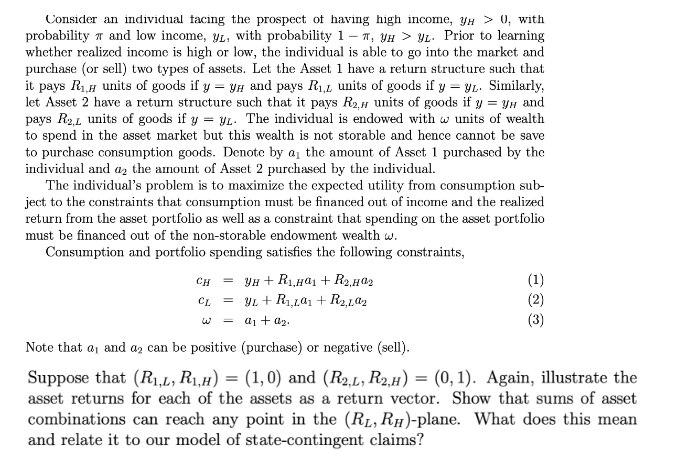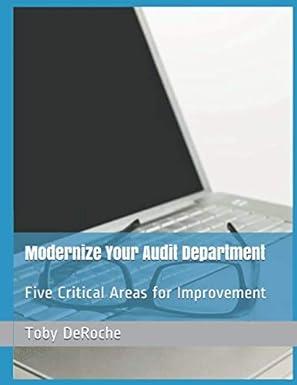 Solve asap
Solve asap
Consider an individual tacing the prospect of having high income, yH>0, with probability and low income, yL, with probability 1,yH>yL. Prior to learning whether realized income is high or low, the individual is able to go into the market and purchase (or sell) two types of assets. Let the Asset 1 have a return structure such that it pays R1,H units of goods if y=yH and pays R1,L units of goods if y=yL. Similarly, let Asset 2 have a return structure such that it pays R2,H units of goods if y=yH and pays R2,L units of goods if y=yL. The individual is endowed with units of wealth to spend in the asset market but this wealth is not storable and hence cannot be save to purchase consumption goods. Denote by a1 the amount of Asset 1 purchased by the individual and a2 the amount of Asset 2 purchased by the individual. The individual's problem is to maximize the expected utility from consumption subject to the constraints that consumption must be financed out of income and the realized return from the asset portfolio as well as a constraint that spending on the asset portfolio must be financed out of the non-storable endowment wealth . Consumption and portfolio spending satisfies the following constraints, cHcL=yH+R1,Ha1+R2,Ha2=yL+R1,La1+R2,La2=a1+a2. Note that a1 and a2 can be positive (purchase) or negative (sell). Suppose that (R1,L,R1,H)=(1,0) and (R2,L,R2,H)=(0,1). Again, illustrate the asset returns for each of the assets as a return vector. Show that sums of asset combinations can reach any point in the (RL,RH)-plane. What does this mean and relate it to our model of state-contingent claims? Consider an individual tacing the prospect of having high income, yH>0, with probability and low income, yL, with probability 1,yH>yL. Prior to learning whether realized income is high or low, the individual is able to go into the market and purchase (or sell) two types of assets. Let the Asset 1 have a return structure such that it pays R1,H units of goods if y=yH and pays R1,L units of goods if y=yL. Similarly, let Asset 2 have a return structure such that it pays R2,H units of goods if y=yH and pays R2,L units of goods if y=yL. The individual is endowed with units of wealth to spend in the asset market but this wealth is not storable and hence cannot be save to purchase consumption goods. Denote by a1 the amount of Asset 1 purchased by the individual and a2 the amount of Asset 2 purchased by the individual. The individual's problem is to maximize the expected utility from consumption subject to the constraints that consumption must be financed out of income and the realized return from the asset portfolio as well as a constraint that spending on the asset portfolio must be financed out of the non-storable endowment wealth . Consumption and portfolio spending satisfies the following constraints, cHcL=yH+R1,Ha1+R2,Ha2=yL+R1,La1+R2,La2=a1+a2. Note that a1 and a2 can be positive (purchase) or negative (sell). Suppose that (R1,L,R1,H)=(1,0) and (R2,L,R2,H)=(0,1). Again, illustrate the asset returns for each of the assets as a return vector. Show that sums of asset combinations can reach any point in the (RL,RH)-plane. What does this mean and relate it to our model of state-contingent claims
 Solve asap
Solve asap





